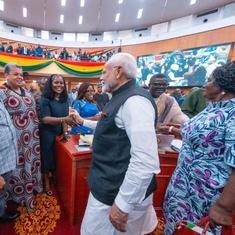When in doubt, my mother’s guru, Hazari Prasad Dwivedi, told me once, seek out the original text. So, as the goons in Rajasthan went on a rampage on January 27 over a film supposedly about a celebrated queen, Padmavati, I turned to Malik Muhammad Jayasi of Amethi. It was this great mystical poet whose 16th-century Awadhi epic Padmavat forms the mother lode for the timeless tale of love between Princess Padmavati (of the fictional island of Simhala) and Ratan Sen, the Rajput king of Chittor, whose fabled fort after his death in battle was razed by Alauddin Khilji, the Islamic patsah of Delhi. It was, as Jayasi reveals, a pyrrhic victory for the emperor, for in this world, true fame can neither be snatched from someone nor bought with money. Read this tale, says Jayasi, and I think it will purify your mind and speech: “Koyee na jagat jas chheena, koyee na leen jas mole/Jo yeh padhai kahani, hum sanvrein dui bol.”
Amethi today is a scorching grid of political power tussles, where men and women in dramatic political costumes of the day are forever getting in and out of Land Cruisers and sports utility vehicles. But in 1540, when the reclusive mystic Jayasi of the village Jayas wrote his Padmavat hidden among the deep forests, Amethi was well insulated from the political power games being played from Awadh to Delhi and Rajasthan. Unlike his predecessor, the mystic poet Amir Khusro, the spectacular glamour and intrigue that inevitably surround the corridors of power had no attraction for Jayasi. Legend has it that the emperor Sher Shah Suri, when he finally sought out the reclusive poet in his forest den, burst out laughing at the sight of a disheveled and rather ugly man. “Do you laugh at me or the potter?” asked Jayasi quietly, and the chastened king hung his head in shame and backed off, they say.
The bare bones of the story of Padmavat are as follows: Ratan Sen, the king of Chittor, hears of the great beauty of Princess Padmavati of Simhala from her pet parrot Hiraman who, terrorised by a cat, has flown his coop. Smitten by the description, Ratan Sen sets out to seek Padmavati, guided by the wise Hiraman, who becomes a guru figure to the hero. The meeting of the lovers after Ratan Sen grapples with all sorts of odds and escapes the gallows by a whisker slowly turns into a metaphor for the human soul seeking out The One and the guru guiding him in a timeless quest that ends in a perfect marriage and merging of bodies and minds. But tragedy awaits them as a playful cat awaits a happy mouse. Back in the kingdom of Chittor, Ratan Sen is betrayed by one wily Raghav Pandit and is killed in battle with the king of Kumbhalner, who has his eyes on Padmavati. The other lusty claimant for Padmavati arrives, the Muslim ruler Alauddin Khilji, who wishes to convert Chittor to Islam and snatch away the beauteous Padmavati whom he has glimpsed in a mirror. With Ratan Sen dead, Khilji storms the fort but by then both of Ratan Sen’s queens, Padmavati and Nagmati, have immolated themselves on his funeral pyre.
The epic ends with a heart-rending couplet:
“Jauhar bhaiein sub istree, purukh bhaye sangram,
Patsahi gadh choora choora Chit Ur Bha Islam.”
(All the women have committed Jauhar, the men all lie dead in battlefield. All the badshah gets is a ruined fort and dead bodies. Ah for such Islamisation of hearts (chit) and mind (ur) at Chittor.)
Familiar as one already was with the tragic vision of war and peace in the epics of Valmiki and Vyas, Jayasi’s last couplet in Padmavat has haunted me ever since I read it for the first time. Its searing but restrained grief was familiar. Yes, one had already met this man on the battlefields of Kurukshetra and Kishkindha and Lanka, where brother was pitted against brother, princely warriors against each other in an imagined gesture of self-negating valour that begins with and ends in nothing but bloodshed, death, pillage and abductions. Is it a coincidence, one wonders, that in India, the most ardent appeals against mindless violence in the name of family honour, legacy and religion were created by poets who had been abandoned at birth or orphaned at an early age – Ved Vyas, Valmiki, Kabir? Those who as orphans led lives of wandering and foraging for survival among ugly palace intrigues and bloody battles to grab thrones. Who eyed this ugly spectacle with the detached sorrow of one who knew its ultimate futility.

Telling a story
Everyone knows that stories are simplifications. To tell a story is to select and to shape constantly to highlight a truth far above the temporal occupations of men and animals. And this – the Karni Sena, which was behind the attack on the sets of the film Padmavati near Jaipur, or the Vishwa Hindu Parishad do not realise – is what Jayasi has done constantly in Padmavat, drawing their timeless wisdom through the channels of peoples’ language, folk songs, sayings and phrases, just as the creators of the Upanishads did before them:
“Jahan na rati na divas hai, jahan paun na ghani,
Tehi ban hoi suvata basa ko re milave ani?”
(There is a space somewhere where no sun shines, where neither air nor day or night exist. That is where my guru, my beloved parrot, wished me to go, who can help me locate him?)
The power of the presence of this great mind within Padmavat is of the kind that belongs to those without any vestige of temporal power of their age. What the present-day bigots in India, Pakistan and Iraq – flailing regularly at art, Sufi shrines and historians – fear above all is the open space an epic like Padmavat offers for interpretation, for uncovering the true healing power of love preached by all religions across time and space. To them, artists cannot be the lord of history but must remain its slave, humbly accepting the sanitised official version they proffer. History, poetry and fear – there is no worse combination in a disoriented society. This disorientation derives in part from a distorted sense of a past constantly recalled and dismissed, in part from a present deprived of certainty, and finally a future full of paranoia and fear of losing power.
What the three great orphan poets Jayasi, Ved Vyas and Kabir fearlessly face is man at war with himself and his own kind – tense, cruel and terrified. Faced with a great fratricidal war, Vyas exiles his own mother Satyavati to a forest, saying the times that are coming are so terrible that each day will be more bloody than the previous one and the earth will age before our eyes. Kabir denounces the temporal world as maya and recedes into a mysterious inner world free of cant and ritual. And Jayasi delves deeper into the mystic message of Islam by entering the lives of the common masses of India, Hindus and Muslims. He leaves behind courtly Persian, the power language of the ruling Muslim elite, in favour of Awadhi. The dialect of the common people becomes his instrument for navigating a complex time when an armed ideology with huge destructive power stalked the land.
In the age of Donald Trump (US president) and Theresa May (British prime minister), we – especially those of us who as children coming out of government-run Hindi-medium schools of the early 1960s have seen vernacular writers, artists and historians on both sides of the Wagah border regularly being dragged into political issues and persecuted for talking sense – can no longer avoid facing the convoluted questions all Indians sharing the Indo-Islamic ecumene face in the 21st century. Jayasi’s wise words become a beacon to all searchers for our real shared past. Like Ved Vyas, he is neither judge, nor protagonist, nor satirist. He observes, watches, listens to all that is exterior to his chosen world of exile and at the same time ponders over the enigma of life, on the fate of man as lover, warrior, powerful potentate. He watches life as life might watch itself: trying to locate a sense that goes beyond the five limited senses with which all are born and die, often no wiser than when they began.
In this imaginary world stretching from Chittor to Simhala, where all perceived reality by its very nature comes out as precarious and ambiguous and predestined for death, stands the tale of Padmavati the queen:
“Oyi uran phal tahiye khavey, jb bha pankhi pankh tanu paye…
Dus batey jehi pinjar mahan, kaise baanch manjari jahan
Ehi dharti tas ketan leeley, tas pet garhi bahuri nahin dheeley”.
(Ever since his feather sprouts, it is the parrot’s karma to fly upwards. But who shall escape the big cat? This earth eats up all that are born and he that enters its womb shall never return.)
Is the Karni Sena even aware of these labyrinths of a mystic mind as it waves swords at perceived enemies of its great culture?










